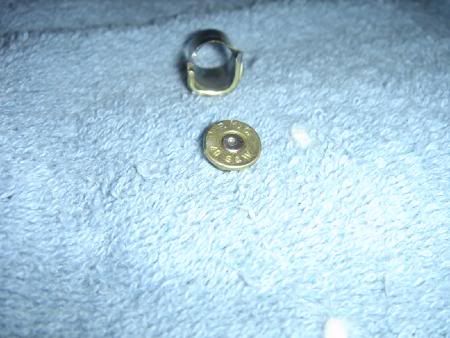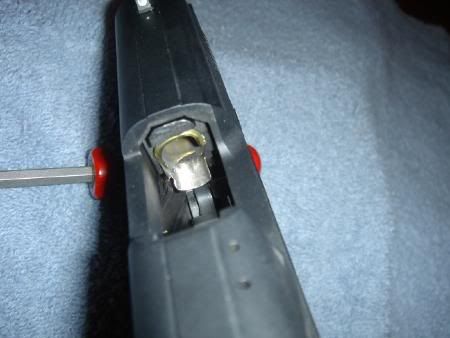Perhaps I am the only one who has experienced this phenomenon. Perhaps I am just unlucky. But I thought I'd share, as it might save you a similar excursion.
As I'm sure you know, some 40 S&W's have a "tapered chamber" or "unsupported" chamber. Glocks being notorious for this condition. Due to this feature, which as I understand it, allows the rounds to feed reliably, the brass swells upon firing to conform to the chamber. You get "guppied" or bulged brass as a result.
It is my opinion that as a result, the brass will wear out more quickly, and it may become unsafe.
Also, as I have read elsewhere, some early cartridges for this number were manufactured with pretty thin case webs, for whatever reasons. PMC among them.
Using otherwise safe data, which I had shot countless times before in the same pistol, I had a cartridge rupture at the case head. I was shooting a Smith and Wesson pistol that was a Walther type, plastic framed pistol. I think they called it a P99. The escaping gas ejected the magazine, and broke the frame, and burst through at a couple of points. I am lucky I suppose, that I suffered nothing more than a cut on my trigger finger near the first knuckle. The scar is still there as a reminder, I suppose.
I'm not sure what to make of the data I take away from this experience. I'm not so arrogant to rule out an overcharge, or maybe even bullet setback caused the problem. For several reasons I do not think an overcharge was the cause. The cause could be the thin web PMC brass. I'm not sure that there is anything that can be done to correct this problem other than to be sure yours is a fully supported chamber. For myself, I decided not to shoot 40 S&W anymore. My reasoning is if the brass has been weakened by "guppying" it may not be safe to use, and I am unaware of any method to determine whether this has happened to the brass, other than to start with brand new cartridges, in a fully supported chambered gun, and only pick up those you know are your own. Some guys roll their brass, or force it through a die to remove this deformation. For myself, I am unconvinced that even if these methods are used, that the resulting correctly formed brass will not still be weakened by an excursion through a Glock-like or Smith and Wesson-like chamber.
I accept that others may disagree with this decision, which is fine, but the data speaks for itself. I guess if you continue to shoot one of these pistols it would be prudent to reload the brass at the lowest powder charge weight.



I now believe that there are varying degrees of "safe" when one speaks of load data, and having had this experience, I truly respect that safety in our hobby ultimately rests on the practitioner. Your decisions are your own, and you alone reap the benefits or suffer the consequences of any decision you make re: powder charge weights, chamber design, seating depth, or brass chosen -- in short, the quality and dimensions of your cartridges.
40 S&W is a high pressure cartridge, notoriously finicky about seating depth and charge weights. There is little margin for error with this cartridge.
One of the lessons I learned from this experience is to not approach maximum powder charge weights in my hand loads, or do so with extreme caution. Another lesson is to be certain that your firearm has a fully supported chamber. Another is to be sure of the origin and condition of your brass, as at this point in my life I purchase new brass for my hand loading, no longer picking up range brass, or purchasing "once fired" brass off the internet. Yet another lesson is that while perhaps one will not achieve the velocities otherwise attainable, typically one can find an accurate load at less than maximum pressures, and by my way of seeing things, by keeping pressures lower, perhaps avoid a repeat of an unpleasant experience.
There are surely other lessons, and I leave it up to you to determine whether any of this is helpful to you.



